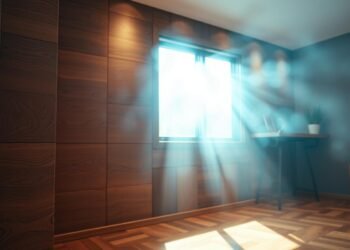Amid the evolving landscape of UK home transformation, a compelling statistic unfolds: loft conversions can inflate the value of a typical three-bedroom, one-bathroom house by an impressive 20%, as suggested by Nationwide. It is this profound potential for adding value to property that solidifies the rationale behind maximising space in the home, and indeed, my fascination with loft renovation has drawn me into penning this DIY loft conversion guide.
As a member of the editorial team at CSAC.org.uk, I am honoured to share with our readers the intricate tapestry of knowledge I’ve gathered, ensuring you’re well-equipped to undertake this rewarding task. With a prudent blend of practicality and creativity, even the uninitiated can embark on a journey to sculpt their redundant rooftop areas into functional living spaces.
My articles are painstakingly crafted to light up the room of curiosity in your mind, mirroring the very essence of skylights that usher rays into renovated attics. Together, we’ll navigate through the intricate weave of beams and trusses that epitomise pre-1960s homes, understand the allure of a flat roof dormer for its simplicity and cost-efficacy, and picture the commanding guide to building regulations, with mandatory minimum head heights and fire safety measures.
We’ll dive deep into the nuances of optimising your house for a potential loft conversion, illustrating that a project’s success isn’t solely dictated by the start of a hammer but by the careful contemplation of feasibility and design. And with a prudent approach to the project, we’ll see how a DIY endeavour can lead not only to enhanced living quarters but also to the immeasurable satisfaction and an enriched lifestyle.
In the subsequent sections, we will unfold the seamless fabric of logic and aesthetics, from the essentials of constructing sturdy floor joists to the finesse of space-maximising layouts. Whether it’s selecting robust materials that marry budget with quality or deploying smart storage solutions that nod to both practicality and panache, rest assured that each word written aim to serve as rungs on the ladder to your loft conversion success.
I invite you to join me on this elevated journey, where every rafter and gabled edge holds the potential to forge not just additional square footage, but create a sanctuary of your very own, nestled amongst the clouds of your aspirations.
Evaluating Your Loft’s Potential for Conversion
When considering a DIY loft conversion, the first crucial step involves assessing the suitability of your loft space. This assessment includes verifying the existing roof structure to ensure it can support the conversion, gauging the minimum headroom, and identifying any potential obstructions that could impede the development.
Assessing Roof Structure and Head Height
In UK homes, the loft’s roof structure plays a pivotal role in determining whether a conversion is feasible. Traditional cut roofs, typically seen in pre-1960s houses, generally offer more flexible space suitable for conversion due to their steep pitches and absence of trusses. On the other hand, modern trussed roofs, common in later constructions, often require more extensive structural modifications to create adequate living space. A fundamental requirement is a minimum headroom of 2.2 metres, which should be available in the central part of the loft to meet UK building standards.
Identifying Obstructions and Services
Another essential aspect of DIY loft planning involves identifying loft space obstructions which might include chimneys in lofts or bulky water tanks. To maximise the usable space, strategies such as water tank relocation or the removal of non-structural chimneys should be considered.
Utilising obstructions for storage effectively or remodelling them can also enhance the functionality of the newly converted area.
Understanding the Importance of Natural Light
Natural light in loft conversions not only makes the space more appealing but also contributes to the energy efficiency of the home. Fitting rooflight windows or undertaking skylight installation are excellent methods of enhancing loft ventilation and brightness, requiring minimal structural alterations. For those looking to maximise headroom and natural light ingress, dormer window planning permission might be necessary, especially if the alterations face the street or significantly alter the roofline.
Overall, carefully considering these factors will determine the loft’s suitability for a conversion and help you plan an efficient and compliant upgrade to your home. It highlights the importance of comprehensive planning and assessment in the early stages, ensuring the feasibility and safety of your loft conversion project.
Navigating Planning Permissions and Building Regulations
Understanding the intricacies of loft conversion planning permission and UK building regulations compliance is crucial for homeowners aiming to enhance their property’s value and usability through a loft conversion. Here, professional drawings for conversions and thorough pre-work assessment are indispensable tools to streamline the process and ensure adherence to local laws and safety standards.

Most loft conversions fall under permitted development, meaning they do not require planning permission if they adhere to specific conditions, such as a maximum volume limit of 40 cubic meters for terraced houses and 50 cubic meters for detached or semi-detached houses. However, for properties in conservation areas or for those listed as historical, different rules apply, often necessitating an application for planning permission despite the size or scope of the project.
Adherence to the UK building regulations is mandatory and includes multiple facets from fire safety, involving the mandatory installation of fire-resistant doors and smoke alarms, to structural stability guaranteed by the assessment of existing joists by a professional structural engineer. It’s important for homeowners to engage with qualified professionals early in the planning stage to prepare the necessary professional drawings for conversions and to understand the scope of work that requires compliance with the Party Wall Act, including serving a Party Wall Notice to neighbours when shared walls are affected.
| Requirement | Details | Consequences of Non-Compliance |
|---|---|---|
| Planning Permission | Required for major modifications or properties in sensitive areas | Fines, enforcement action, reversal of work |
| Building Regulations | Includes fire safety, structural stability, and insulation standards | Potential fines, mandatory reversal of non-compliant work |
| Party Wall Act Compliance | Notice required for any work affecting shared walls or boundaries | Disputes resolution, potential legal challenges |
Failure to comply with these regulations or to obtain the necessary permissions can lead to significant issues, including legal disputes, fines, and even the requirement to demolish the unauthorized works. Furthermore, securing a completion certificate from building control is essential to confirm that the modifications meet UK building regulations, thus adding to the property’s value and ensuring safety and efficiency standards are met.
Ultimately, the journey of modifying a home with a loft conversion while navigating the maze of loft conversion planning permission and understanding Party Wall Act regulations calls for meticulous planning, professional guidance, and an in-depth appreciation of the legal frameworks governing property alterations in the UK.
DIY Loft Conversion: Essential Steps and Considerations
Embarking on a DIY loft conversion presents an exciting challenge that not only enhances your living space but also contributes significantly to your property’s value. Understanding key considerations such as design, budget, and insulation is crucial in optimising the functionality and efficiency of your loft space.
Designing Your Space: Layout and Aesthetics
When beginning a loft conversion, it’s vital to optimise the available space smartly. Customising your loft space allows for a practical layout that includes essential features such as a protected means of escape and room-specific additions like integrating loft staircases. Each design decision should comply with architectural loft considerations, enhancing both the use and value of the space. For instance, carefully placed skylights enhance natural light, while thoughtful placements of partitions can help create distinct, functional areas within the open-plan loft.
Selecting Materials: Balancing Budget and Quality
Selecting the right materials is critical in striking a balance between maintaining a budget and ensuring quality. Utilising cost-effective loft conversion materials does not necessarily mean compromising on quality. Many sustainable building options provide both environmental and economic benefits. The table below provides a comparison of the average costs for different types of loft conversions, offering insights into budgeting for your DIY loft projects based on the desired conversion style:
| Type of Loft Conversion | Cost Range |
|---|---|
| Velux Loft Conversion | £10,000 – £15,000 |
| Dormer Loft Conversion | £20,000 – £30,000 |
| Hip to Gable Loft Conversion | £25,000 – £35,000 |
| Mansard Loft Conversion | £30,000 – £40,000 |
Insulating Your Loft: Achieving Energy Efficiency
Effective insulation is paramount in any loft conversion, significantly impacting both the comfort and the energy costs of your home. Utilising high-performance insulation materials in insulating rafters, walls, and floors ensures the space is well-protected against heat loss. Ensuring that your loft conversion insulation adheres to the latest energy efficiency standards in lofts can reduce energy costs and contribute to a sustainable environment. The precise installation of insulation is crucial; improper insulation can lead to increased heat loss and moisture issues, counteracting the energy-saving benefits.

In conclusion, a well-planned DIY loft conversion can significantly improve your living space and property value. From the planning stage, incorporating energy-efficient practices and utilising the correct materials, to carefully designing the space and carrying out the conversion yourself, each step should be approached with detailed consideration. Although challenging, the rewards of a bespoke, efficiently designed loft are long-lasting and substantial.
Maximising Space and Light in Your Loft Conversion
Enhancing your home through a loft conversion not only adds value but can transform unused attic spaces into vibrant, light-filled living areas. Key considerations such as the choice of windows, storage solutions, and the utilisation of distinctive architectural features define the success of these conversions.
Choosing the Right Types of Windows
One of the first steps in a loft conversion is to determine appropriate window installations that contribute to both aesthetics and functionality. Rooflight windows and Velux window installations are popular choices because they require minimal structural alterations for windows, yet significantly enhance loft space with natural light. For those looking to maximise space, dormer window planning is essential; dormer windows not only increase the headroom but also improve the loft room aesthetics and are subject to specific planning permissions especially if they are to face the street.
Smart Storage Solutions
Efficient use of space is possible through innovative loft storage strategies and customised storage options. Utilising sloped ceiling design, homeowners can incorporate eaves access hatches or develop roll-out storage bins that blend seamlessly into the architecture without compromising the bespoke loft conversion design. A well-planned approach not only helps in utilising loft space effectively but also maintains clean and practical loft layouts.
Utilising Sloped Ceilings to Your Advantage
Lofts inherently include sloped ceilings and unconventional angles, which can be cleverly used to enhance the space. Deliberate sloped ceiling design and creative use of loft angles allow for the bespoke loft conversion design that is both practical and aesthetically pleasing. These elements can be transformed into visually appealing features, turning potential limitations into unique details that enrich both the character and functionality of your loft conversion.
By focusing on integrating natural light through strategic window placement, adopting innovative storage solutions, and embracing the unique features of loft structure, homeowners can ensure they maximise the potential of their loft conversion effectively and beautifully.
Conclusion
Finalising a DIY loft conversion is undeniably a momentous milestone within the realm of UK loft renovation outcomes. It reflects not just the physical transformation of a space but the accomplishment of successful home space optimisation. The journey from conceptualising to loft conversion project completion can enhance a property’s value by up to 20%, a sizeable figure in the UK housing market. With the average DIY conversion cost ranging between £20,000 and £50,000, the financial implications are considerable, yet the cost savings, particularly in labour, compared to professional services, are undeniable.
The statistics illustrate that internal loft conversions can be a more economical choice, being generally 30% less expensive than dormer conversions. Moreover, the practicality of these projects is reflected in the fact that around 60% of them are executed without necessitating planning permission, falling neatly under “permitted development” rules. Nevertheless, attention to detail is crucial with such undertakings as mistakes can inflate costs by up to 30%, amplifying the importance of professional input in certain aspects. The minimum head height of 2.2m is a critical factor for a feasible conversion, and while the allure of creating a custom staircase is tangible, the associated costs can be steep, sometimes tenfold that of a standard staircase.
In essence, DIY loft conversions present a dual-faceted scenario; they offer substantial cost savings and self-satisfaction but are not without their challenges. Striking the right balance between DIY endeavours and professional guidance can be key to navigating the intricacies of regulations and building standards. Loft conversions, when well-executed, not only optimise space but ensure safety, with fire protection being a paramount consideration. While costs can vary based on the roof’s structure—traditional cut rafters versus modern trussed rafters, for instance—the endeavor can be a profoundly educational and financially beneficial journey. For those with the requisite skills, resilience and commitment, completing such a project can signify a reverberative triumph in home improvement and personal achievement.














